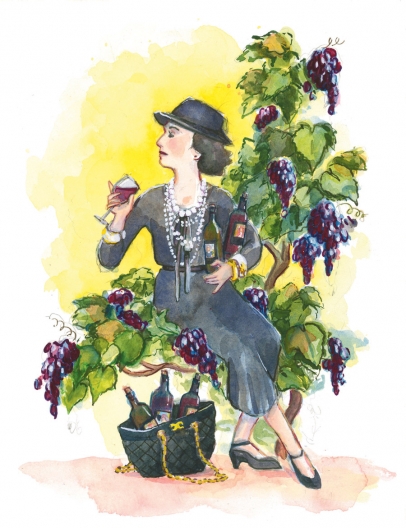Rutherford Meets the Runway
CHANEL INC.’S PURCHASE OF NAPA VALLEY’S ST. SUPERY ESTATE DEEPENS THE WINERY’S FRENCH CONNECTION
With a notable lack of fanfare seemingly out of step with the global luxury brand’s usual penchant for creating media sensations around other aspects of its business ventures, France-based Chanel Inc. purchased Napa Valley’s St. Supéry Estate Vineyards & Winery in the fall of 2015. In the two years since, it appears that the acclaimed maker of Bordeaux-style wines is still keeping its new ownership out of the spotlight. On a recent visit I did not find a single instance of the fashion house’s iconic interlocking C logo on display, not even in the high-end retail boutique in the winery’s tasting room.
Currently headed by brothers Alain and Gerard Wertheimer, Chanel Inc. traces its roots back to 1870, when Alain and Gerard’s ancestor Ernest moved from Alsace to Paris during the Franco-Prussian war. Originally begun as a producer of theatrical makeup, the company transformed into a high-fashion powerhouse under the creative direction of Coco Chanel.
Chanel also owns the Rauzan-Ségla and Chateau Canon wineries in France, but St. Supéry Estate is the company’s first winery acquisition in the United States.
THE MAKING OF ST. SUPÉRY ESTATE
Back in the 1920s, when fashion legend Coco Chanel was already in her 40s, St. Supéry Estate Vineyards and Winery wasn’t even in the planning stages. Its founding family’s French and Algerian winery and vineyard holdings would operate for some 50 more years before third-generation vintner Robert Skalli migrated the family’s wine business to California.
Skalli spent eight years searching for the perfect property before purchasing the 1,531-acre Dollarhide Ranch in Napa Valley’s then—relatively unknown northeastern appellation in 1982. Purchasing 56 additional acres in Rutherford in 1985, he constructed St. Supéry’s French chateau—style winery.
Today, St. Supéry produces 100% estate-grown and sustainably farmed wines of the highest quality. St. Supéry’s Dollarhide Estate and Rutherford Estate and the winery itself are all certified Napa Green (NapaGreen.org).
St. Supéry’s current winemaker is Australian Michael Scholz, who brings four decades of experience working in countless global wineries to St. Supéry. Additional winemaking advice comes from Bordeaux’s celebrity wine consultant Michel Rollan.
Since 2009, Emma J. Swain has served as CEO of St. Supéry. Swain is also the past chair of the board of the Napa Valley Vintners Association and a board member of the Wine Market Council. She says she was particularly inspired to work with St. Supéry because of the winery’s rich history of producing estate-grown wines and “unyielding integrity and long-term dedication to winemaking and viticulture, all qualities I hold dear.”
With this top-notch team in place, and new owners dedicated to furthering his vision of producing the highest-quality wines, founder Robert Skalli said at the time of the sale of the winery he founded 35 years ago that he believes he has left St. Supéry in good hands. “I am delighted to hand over St. Supéry to such a well-regarded company that understands luxury brands and will continue to enhance this special property. I am confident that they will continue my vision of a Napa Valley chateau, crafting world-class estate wines, and will build on that foundation, ever improving quality.”
THE MAKING OF CHANEL
Back in the early 20th century, when a woman’s place was in the home—mainly the kitchen and bedroom—the drive and ambition of Jeanne Gabrielle “Coco” Chanel went against all odds. Coco’s story is one of independence and survival. Born out of wedlock, Coco and her sisters were left in the care of various strangers while their parents (who wed after she was born) traveled the world. When her mother died, the children were sent to a convent orphanage, and so began a pre-teen’s fashion influence: The black and white robes of the nuns would later become the signature Chanel color scheme, and Coco’s iconic single strand of white pearls were symbolic of the only fashion accessory to which she was exposed at an early age: rosaries.
Young Coco spent much of her time at the convent learning how to sew; summertime visits to her aunt were an education in millinery. By age 20, she had established her unique sense of style and sensuality in fashion, and with the opposite sex. Her nickname, “Coco,” was conceived during her party years while living in Moulins and singing in a nightclub nearby. Some say the nickname evolved from a song she sang, titled “Who’s Seen Coco in the Trocadero,” while others say it was in reference to the designer’s predilection for cocaine.
THE AGE OF ALIGNMENT
Had Coco tasted St. Supéry’s 2015 Dollarhide Estate Vineyard Sauvignon Blanc, she might have opted to pass over the white powder for this wine’s stimulating tropical melon aroma and powdery-grape fruit finish with a great mouthfeel derived from spending seven months in an oak barrel.
Coco’s strong personality is in sync with the 2012 St. Supéry Estate Cabernet Sauvignon. The label for this limited-production blend of 88% Cabernet Sauvignon and 12% Malbec showcases the high elevation of the winery’s Dollarhide Estate vineyard, the grapes from which create a wine that can best be described as subtly elegant; far from ostentatious.
“Fashion changes, but style endures,” Coco is quoted as saying. Elegant wines endure, as well. St. Supéry and Chanel—looks like a perfectly suited match to me.





